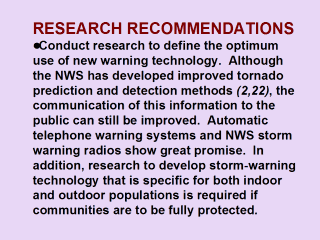 |
- Develop methods to protect our increasingly aging population from
tornadoes. Because of hearing or vision loss, elderly people may be unable
to benefit from new technological developments in warning systems that
depend on one's being able to see or hear well. Research is required to
determine the best methods to warn and shelter this vulnerable segment of
the population.
Standardize the collection of data
by medical examiners or coroners following natural disasters.
Develop standard definitions for
tornado-related injury and death.
Ensure that teams investigating the
effects of tornadoes contain multidisciplinary components. Because tornado
disasters involve the correlation of physical and meteorological
information with epidemiologic data, multidisciplinary research teams are
necessary to optimally study the health effects of tornadoes.
Conduct further research into the best use
of the new technology and modern media resources for disseminating weather
warnings. Concerns have arisen that frequent "false positive" tornado
watches might make people less likely to seek shelter when warned in the
future.
|
